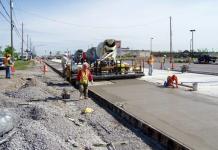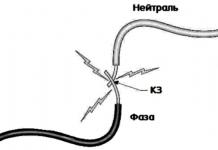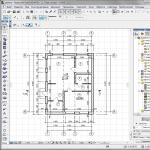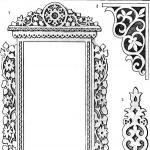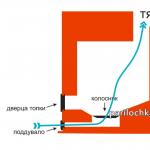Not everyone knows what an RCD is, much less a differential circuit breaker. And these are very necessary and important devices that will solve the problem of electrical safety in the house.
RCD- residual current device, also called differential switch ( VD). By monitoring the wiring if any leaks occur, the RCD turns it off. At the same time, without protecting the electrical wiring from overloads or short circuits.
RCDs are used:
- To ensure human protection from direct and indirect electric shock;
- To prevent fire hazards due to current leakage.
Most devices have a metal body. A washing machine, microwave oven, electric oven, and other household appliances may conduct current due to their malfunction.
Wear, mechanical or thermal effects lead to disruption of the conductor insulation, and a short circuit to the metal body of the equipment may occur. In this case, a phase equal to the mains voltage will appear on the housing. Surely everyone has ever felt 
The RCD must be protected by a circuit breaker or fuse. It works if if electrical wiring with a PE protective conductor is used (phase, neutral, ground)
Working in tandem with a machine, it turns out that one device protects against leaks, and the other against overloads.
Without using a grounding system, a person will feel only a short-term shock, equal to the response time of the RCD.
When faulty wiring is used, or poor-quality installation is carried out, a fire may occur. The RCD will prevent this situation by disconnecting the network. You need to select an RCD with a response setting from 300 to 500 (mA)
Sometimes, the outlet line may be overloaded, and experts recommend purchasing an RCD with a rating one order of magnitude higher than the rated current of the protection device. For example, the input device for an apartment has an indicator of 50 (A), respectively, we install the RCD according to the indicator of 63 (A).
There is a standard range of rated residual currents in RCDs: 6 (mA), 10 (mA), 30 (mA), 100 (mA), 300 (mA) and 500 (mA).
What is a differential machine
In simple terms, a difavtomat is an automatic differential current switch ( RCBO). This device combines the capabilities of an RCD and a circuit breaker. It turns out, two in one.
The difavtomat is used for:
- Protection of the electrical network from overload and short circuit;
- Preventing all kinds of leaks associated with faulty electrical wiring, household appliances and human exposure to voltage.
Types of RCDs and automatic devices
RCDs and difavtomats are divided according to the following criteria:
1.By type of differential current leakage
- Type AC, in which the device instantly responds to an alternating current leak;
- Type A, triggered by AC and DC leakage, a universal option, but more expensive;
- Type IN, which is used for industrial facilities.
2. By time delay
- Selective type S, which is connected when several RCDs are used in a line, and which is triggered if a group RCD turns off;
- Type G it is also selective and has a time delay for operation of 0.06-0.08 (s).
The manufacturer indicates all designations of types of RCDs and automatic devices on the housing

3. By trigger type
- Electromechanical- do not depend on the network, and the source of their operation will be differential current;
- Electronic- depend on the mains voltage, and to operate they need an external source. Manufacturers build an electromagnetic relay into it, thereby disconnecting the load circuit.
4.By number of poles
- Bipolar- used in a single-phase network to prevent fire. Available for rated voltage 230 (V);
- Four-pole- for a three-phase network. Designed for a nominal voltage of 400 (V).
5. By design
- Portable - installed in place of the outlet or connected to it, and household appliances are connected to them;
- Stationary.

How to choose the right RCD and difavtomat
These devices are very similar, but the manufacturers immediately indicate what is in front of you on the front side or on the side of the cover. In stores you will find devices from companies such as IEK, EKF, TDM, ABB, Legrand, Schneider Electric and others.
Their price range may vary depending on the type of work and design. For example, portable RCDs are easy to use, and their price is higher than stationary ones. And a good automatic device costs less than an RCD included with a conventional automatic machine. But the repair process when a RCD with a machine breaks down will be cheaper, since either one or the other element is changed. If the automatic machine breaks down, you will have to replace it entirely. But, ease of installation and reliability of the chain give it an advantage.
When choosing, you need to look at the device’s passport and fire safety certificate, as counterfeits are often found.
You should also pay attention to:
- Marking. If the rated current value is indicated on the body without other symbols and letters, this is an RCD. If the current value is preceded by a letter B, C or D- This is a differential machine.
- Scheme. Take a careful look at RCD: The oval indicates a differential transformer. On the diagram difavtomat In addition to the oval, you can see the winding of electromagnetic and thermal releases, which reacts to short circuits and overloads. It's simple.
Advice. Choose a difavtomat in those areas where the voltage is high - boiler room, utility unit. RCD + automatic - lighting lines, groups of sockets. If we talk about apartment wiring, then there is no fundamental difference in what to choose.
Bathrooms and bathhouses are places of increased danger, so it is worth using an RCD installation there with a differential current of 10 (mA), with a separate line. When a line is combined, for example, with a corridor, an RCD with a setting of 30 (mA) should be used.
R.S.
Among our readers, there are probably experts who have a deeper knowledge of the intricacies of this issue. We will be glad and grateful if you leave some corrections and clarifications in your comments.
How the RCD works:
All RCDs belong to the category of electronic protective equipment. However, in terms of its functionality, the residual current device differs significantly from standard circuit breakers. What is their difference, and how does an RCD work in comparison with an automatic machine?
Everyone knows that over time, wire insulation ages. Damage may occur, and the contacts connecting live parts gradually weaken. These factors ultimately lead to current leakage, which causes sparking and further fire. Often, people may accidentally touch such emergency phase wires that are under voltage. In this situation, electric shock poses a serious danger.
Purpose of RCD
Residual current devices must respond to even minor short-term current leaks. This is their main difference from circuit breakers, which operate only during overloads and short circuits. Automatic machines have a very high time-current response characteristic, while an RCD operates almost instantly, in the presence of even the most minimal leakage current.

The main purpose of the RCD is to protect people from possible electric shocks, as well as to prevent dangerous current leaks.
Operating principles of RCD
From a technical point of view, any RCD is a high-speed switch. The operating principles of the residual current device are based on the response of the current sensor to the changing current flowing in the conductors. It is through these conductors that current is supplied to the electrical installation, which is protected by the RCD. A differential transformer is wound onto the core, which is a current sensor.

To determine the response threshold of an RCD having a certain current value, a highly sensitive magnetoelectric relay is used. The reliability of relay structures is considered quite high. In addition to relay ones, electronic device designs have now begun to appear. Here the threshold element is determined by a special electronic circuit.
However, conventional relay devices seem to be more reliable. The actuator is activated using a relay; as a result, the electrical circuit is broken. This mechanism consists of two main elements: a contact group designed for maximum current and a spring drive that breaks the circuit in the event of an emergency.

To check the serviceability of the device, there is a special circuit inside it that artificially creates a current leak. This triggers the device and makes it possible to periodically check its serviceability without calling specialists to carry out electrical measurements.
The direct operation of the RCD is carried out according to the following scheme. A situation should be considered where the power supply system is operating normally and there are no leakage currents. The operating current passes through the transformer and induces magnetic fluxes directed towards each other and equal in magnitude. When they interact, the current in the secondary winding of the transformer has a zero value, and the threshold element does not operate. When a current leak occurs, an imbalance of currents in the primary winding occurs. Because of this, a current appears in the secondary winding. Thanks to this current, the threshold element is triggered, and the actuator is activated and de-energizes the controlled circuit.

From a technical point of view, the residual current device consists of a fire-resistant plastic housing. On its back there are special locks for installation on an electrical panel. In addition to the elements already discussed, an arc suppression chamber is installed inside the housing, which neutralizes the electric discharge arc. Clamps are used to connect the wires.
RCD operation parameters
To correctly select the device trigger setting, you should remember the danger of alternating current to humans. Under its influence, cardiac fibrillation occurs when contractions are equal to the frequency of the current, that is, 50 times per second. This condition causes a current starting from 100 milliamps.
Therefore, the settings at which the RCD is triggered are selected with a margin of 10 and 30 milliamps. The lowest values are used in high-risk areas, such as bathrooms. The highest settings are 300 mA. RCDs with such settings are used in buildings, protecting them from fires due to damaged circuits.

When choosing an RCD, the rated current, required sensitivity and number of poles are taken into account, in accordance with the phases of the supply network. It is necessary to check the degree of thermal stability of the device, as well as the ability to turn it on and off, based on the calculated network parameters.
The rated current value for the RCD must be higher than that of the machine. A lower current rating of the machine will protect the RCD from damage in the event of a short circuit in the circuit.
How to connect an RCD
All terminals on the RCD body are marked with the corresponding letters. Terminal N is for the neutral wire, and L is for the phase wire. Therefore, they must be connected to their own terminals.
Also, it is necessary to take into account the position of the entrance and exit and under no circumstances change their places. The entrance is located at the top of the device. The power wires running through the input machine are connected to it. The output is located at the bottom of the RCD and the load is connected to it. If you confuse the position of the input and output, then false triggering of the residual current device or its complete failure may occur.

Installation of RCDs is carried out together with conventional circuit breakers. Thus, devices installed together provide protection not only from short circuits and overloads, but also from leakage currents. At the same time, the RCD itself, which is connected behind the input machine, is protected.
Connecting a residual current device in an apartment or private house has its own characteristics. For apartments where a single-phase network is used, the RCD connection diagram is assembled as follows, following a certain sequence: input machine => electricity meter => RCD itself with a leakage current of 30 mA => the entire electrical network. For consumers with high power, it is recommended to use their own cable lines with the connection of separate residual current devices.
In large private houses, the connection diagram for protective devices differs from apartments due to its specifics. Here, all devices are connected as follows: input circuit breaker => electricity meter => input RCD with selective action (100-300 mA) => circuit breakers for individual consumers => RCD for 10-30 mA for individual groups of consumers.
RCD errors when connecting
Correct connection of protective devices is the key to reliable operation of the entire electrical network.
Residual current device (RCD) and differential protection (Difavtomat)
INIn this article, the author will try to explain as simply as possible the purpose, design features, technical characteristics of RCDs (electromechanical and electronic) and differential protections, differential circuit breakers, or as commonly abbreviated as differential circuit breakers, as well as their differences, examples of connection diagrams, etc..
Let's start with the Rules, or rather, excerpts from the Rules and pay attention to the highlighted text (must, allowed, mandatory, required, recommended, etc., so that you can decide for yourself where it is mandatory to install an RCD or a Difavtomat, and where, at your discretion, to install or not).
Go to page PUE 7 excerpts from:
In general, the conclusion from the Rules is this: RCDs are not a panacea for all problems with electricity, but work in conjunction with other protective devices and can be installed in accordance with the Rules, where it is mandatory, and where it is not necessary, but recommended.
Purpose of RCD and differential protection:
A residual current device (RCD) or a differential circuit breaker is used to protect people from electric shock in industry, agriculture, everyday life, etc. Moreover, they cannot be considered as an alternative to other safety measures; moreover, the GOST R-30331.3 standard classifies them as auxiliary devices and additional methods of protection from direct touch . For these purposes, as well as for protection against indirect contact in the Russian Federation, RCD-D with diff. shutdown current is about 30ms. Devices with large diff. current shutdowns are used to protect electrical equipment from the consequences of leakage currents (fires, equipment failure).
Direct touch:
Direct touch refers to human contact with a part of the electrical wiring that is energized during operation. In other words, a person touching open wires, contacts, terminals through which electric current flows in normal (not emergency) modes is a direct touch.
Indirect touch:
 Indirect touch is inherently more dangerous than direct touch. If a direct touch is more likely an accident caused by an oversight, then an indirect touch occurs in an emergency situation and the person does not know in advance that this or that structure is energized.
Indirect touch is inherently more dangerous than direct touch. If a direct touch is more likely an accident caused by an oversight, then an indirect touch occurs in an emergency situation and the person does not know in advance that this or that structure is energized.
Table of damage current values and its consequences for human exposure:
How the RCD works:

Inside the RCD there is a special transformer (see Fig. 1), in which each of the conductors (L-phase, N-zero) creates an electromagnetic field. During normal operation, they cancel each other. When a current leak occurs, an imbalance of the electromagnetic field occurs in the coil, as a result, the rod pushes the lever to turn off. Such a device is triggered to switch off from current leakage, but is not intended to protect against short circuits and network overloads, i.e. the residual current device itself reacts only to differential currents and does not operate with short-circuit currents (phase-zero) and overload currents, so it is necessary to install an additional circuit breaker. In Fig. Figure 1 shows a purely schematic diagram of the operation of an RCD; the device itself contains many more elements - filters for protection against interference and false alarms and some other electronic components, but the described principle of operation is basic for residual current devices.


Rice. 2 Fig. 3
The operating principle of an RCD is based on measuring the current difference in conductors passing through a differential current transformer. The RCD measures the vector sum of currents flowing through the controlled conductors (two for a single-phase RCD, three or more for a three-phase version). In normal operating mode, the vector sum of the currents flowing through the measuring transformer is 0 (the current “flowing” through one conductors is equal to the current “flowing out” through the others, see Fig. 2), and the device does not operate. When a leakage current appears (a person touches the phase conductor, or a decrease in the insulation resistance of the cable line), the vector sum of the currents flowing through the RCD will not be equal to 0, since a leakage current appears that flows only through the phase conductor (see Fig. 3), in a voltage proportional to the leakage current will be induced in the secondary winding of the transformer, and if a certain threshold is exceeded, the device will operate and the protected circuit will be disconnected.
RCDs are single-phase and three-phase. In addition, there are now two different types of RCDs on sale, differing both in price and reliability - electromechanical and electronic RCDs, see Fig. 4:

Rice. 4 RCD diagrams and designations
In terms of design, it is important to note that:
Single-phase RCDs, which are most often used in everyday life, usually have a two-pole design, i.e. when installed in an electrical panel on a DIN rail, two modules are occupied. If we do not consider replacing the input circuit breaker + RCD with a differential circuit breaker, then usually a single-pole circuit breaker is installed in series with the RCD. In the general case, a combination of RCD + circuit breaker when installed on a DIN rail will occupy three modules, and a differential circuit breaker will occupy two modules (which is important when installing in panels to save space for circuit breakers). It turns out two in one: RCD + Circuit breaker = Differential circuit breaker.
How to choose the right RCD, electronic or electromagnetic, first of all, look at the technical characteristics of the device, the manufacturer’s workmanship, in addition, residual current devices are of type A and AC, which is further described in detail in the following articles:
Go to page:
Differential circuit breaker:
Differential circuit breaker (differential current protection and general protection) is designed to protect the circuit from current leakage (similar to the operation of an RCD), but the advantage of differential. machine is that it has a built-in circuit breaker, which performs the function of protecting the circuit from short circuits and overloads.
Go to page:
RCD - residual current device. Many have probably heard, and someone may know what this device is, what it is for and how it works. Without delving too much into the jungle of physics, we will briefly try to understand the structure and operating principles of this very thing in simple human language.So, as the name itself suggests, This device is designed to protect against electric shock. The operating principle of the device is based on comparing the currents along the conductors at the input and output of the device. The currents must be equal. If there is a slight difference, the device “sees” it and immediately disconnects the load from the network. The response time, according to standards, should be no more than 15-25 ms.
For example, if an insulation breakdown occurs on the body, and it does not matter whether it is a phase wire or a neutral wire, in any case, when a person touches the body of the device, it will happen through the person’s body, to which the RCD will immediately respond and turn off the damaged device, thereby saving the person life. Here is, perhaps, the simplest and most understandable example, for a person far from physics.
Now, in fact, we will begin to review the reasons due to which, in practice, the RCD is triggered.
As we found out earlier, The RCD is triggered when current leakage occurs. Cracks in the insulation of worn-out wires in older buildings can cause this type of leakage. In this case, the activation of the protection prevents the occurrence of a fire.
What to do in this case? There is only one answer - look for possible places of current leakage. You can, of course, get by with simpler methods, for example, simply eliminating the RCD from the circuit, but no one knows what this will lead to.
The wiring can last for decades, but it can also lead to disaster. And electricity, as you know, does not like jokes and does not forgive negligence.
In addition to wear and tear on the wires, the tripping of an RCD often causes wear and tear, and therefore breakdown of insulation in household appliances. For example, sometimes old refrigerators, washing machines, etc. can cause the RCD to trip.
Sometimes, in 50% of cases, manipulation of the plug and socket helps to get rid of the RCD triggering, that is, simply turn the plug over in the socket.
Video on the topic. The RCD can also be switched off if it is connected incorrectly. The reasons for the RCD tripping are installation errors. The main mistakes are discussed in this video.
The impact of electricity has a detrimental effect not only on human life and health, but also on the entire number of consumers who, without proper protection, fail. Differential protection devices have become widespread. Which is better: ouzo or differential automatic? To answer this question, it is necessary to study them in detail, and then draw conclusions.
Residual current devices
When laying electrical wiring or upgrading it, circuit breakers are not enough. The main criterion is electrical safety, because electricity not only has useful properties, but can also lead to huge problems (financial difficulties, threats to health and life).
To protect electrical wiring, devices and devices, specialized devices are used, which are called differential current devices. They protect not only from current leakage and from exceeding the electrical parameters of the network, but also from short circuits. This is a necessary measure, because it is impossible to control electricity while, for example, at work. This often leads to equipment failure, accidental fires and fires.
Nowadays, differential automatic devices and RCDs have become widespread. And many people are very concerned about ouzo or difavtomatic - what to choose?
Troubles when using home wiring
Before you begin choosing a differential protection model, you need to find out from what adverse factors the electrical network should be protected.
The main problems of an unsecured network:

Danger at home- electric shock to a person. For example, when you touch a pump or microwave, you feel the unpleasant effect of current on the human body. This is where the danger lies, because today there will be a weak blow, and after a while the phase will give a breakdown in the body of the product.
According to electrical safety regulations, a voltage of 220V and a current of 1.5mA are safe for humans. At currents up to 7 mA, convulsive phenomena are felt, and at 10 mA a person is no longer able to tear his hand away from the current-carrying part.
But these values in real life differ significantly. It all depends on the resistance of the person’s body and the method of touch. Body resistance depends on many factors, here are some of them: air humidity, moisture on the floor, shoes, clothing, genetic characteristics, nutrition and even mood.
Criteria for choosing differential protection
In order to clarify the next problem of choice (difavtomatic or ouzo - which is better?), it is necessary first of all understand their operating principle, scope of application, design features, occupied space, cost, difficulty of repair and connection, troubleshooting, ease of installation.
Design and installation features
 For home use, single-phase ouzos are usually used and have a bipolar design. They must be used together with a circuit breaker, because the ouzo protects the electrical network or circuit section from leakage currents, and the circuit breaker protects from overloads and short circuits. This design occupies 3 modules in the panel.
For home use, single-phase ouzos are usually used and have a bipolar design. They must be used together with a circuit breaker, because the ouzo protects the electrical network or circuit section from leakage currents, and the circuit breaker protects from overloads and short circuits. This design occupies 3 modules in the panel.
Ordinary single-phase automatic circuit breaker made in 2-module, but there are models that are produced in a single-module design. If there are several difavtomats or several ouzos, then the space savings will be significant.
It is not difficult to install an ouzo or difavtomat - convenient clamps allow you to do this without problems, but there are some nuances here too.
For comparison, diagram 1 shows the switching of a pair of ouzo with an automatic machine and a difavtomat. Therefore, connecting the difavtomat is much simpler.
Scheme 1 - Scheme for comparing the switching of an ouzo+automatic machine and a difavtomatic machine
Diagnostics and maintainability of circuits
Each of the differential protection devices under consideration is designed for circuit break if triggered. To find out the reason why the operation occurred, it is necessary to carry out some diagnostics.
 When a pair is installed (automatic and circuit breaker), the problem that has arisen can be immediately identified. When the ouzo was triggered, a current leak occurred on some line. If the circuit breaker has tripped, then there is an overload or short circuit in the electrical network.
When a pair is installed (automatic and circuit breaker), the problem that has arisen can be immediately identified. When the ouzo was triggered, a current leak occurred on some line. If the circuit breaker has tripped, then there is an overload or short circuit in the electrical network.
But if the automatic transmission is installed, identifying the cause becomes more difficult. Some expensive models are equipped with a special indication that indicates leakage or overload.
Default protection devices may also fail. For example, with frequent triggering for no reason or with a clearly overloaded line. In this case, the thermal protection circuit is most likely faulty (malfunction of the bimetallic plate). In the case of a pair of RCD and AV, as a rule, 1 element fails, which can be replaced, which is cheaper than purchasing a breaker.
Operating principle of RCD and difavtomat
An RCD is used to identify and protect against leakage currents. The principle of operation is based on comparing the magnitudes of currents (incoming and outgoing).
Figure 1 - RCD (Residual current device or differential switch)
RCD device:
- Toroidal transformer with 2 primary windings and one control winding.
- Electromechanical relay (key).
 The control winding is connected to the switch, and during normal operation of the device, the currents on the 2 primary coils create magnetic fluxes. Moreover, these coils are wound in opposite directions. When added together, these magnetic fluxes give a resulting magnetic flux in the core equal to zero. However, when a leakage current appears, this rule is violated, and a magnetic flux is formed on the control coil due to a difference in magnetic fluxes other than zero. This magnetic flux causes the switch to operate and the circuit opens. The response time of the RCD (differential switch) is in the range from 0.2 to 0.3 seconds.
The control winding is connected to the switch, and during normal operation of the device, the currents on the 2 primary coils create magnetic fluxes. Moreover, these coils are wound in opposite directions. When added together, these magnetic fluxes give a resulting magnetic flux in the core equal to zero. However, when a leakage current appears, this rule is violated, and a magnetic flux is formed on the control coil due to a difference in magnetic fluxes other than zero. This magnetic flux causes the switch to operate and the circuit opens. The response time of the RCD (differential switch) is in the range from 0.2 to 0.3 seconds.
Particularly widespread 30 mA devices, and in rooms with high humidity - 10 mA.
A difavtomat or automatic differential current switch (RCCB) combines an RCD and an AV (automatic circuit breaker).
Figure 2 - Difavtomat
Absolutely all RCBOs are superior to RCDs in response speed (0.04 seconds) and allow you to quickly turn off power to sections of the circuit during voltage surges over 250V.
Price
Solving this issue is quite simple. The cost of a pair of RCD and AV is lower than the cost of the automatic device itself. After all, if any element of this pair fails, it is necessary to replace the AV or RCD (cheaper than changing the automatic circuit breaker). It is advisable to immediately purchase high-quality devices, because the stingy pays twice. And when purchasing a high-quality differential protection device, fewer problems arise. The best brands are Schneider Electric, General Electric and ABB.
 An example showing how to select a particular device.
An example showing how to select a particular device.
A powerful device (15A and 1.5 kW) was purchased, to which a separate power supply line must be connected. For this case, you will need a 16A AV and an RCD (30mA). It is necessary to add up the costs of the devices and compare the resulting cost with the price of the RCBO. If it is necessary to install protection on 8 lines, each of which consists of 4 groups for a pair of RCD and CB: 6 AV * (cost of one CB) + 3 RCD * (cost of 1 RCD).
Nothing can be done for automatic machines, since 8 of them are needed (1 RCBO per 1 line). We calculate the amounts and find that installing RCBOs is much more expensive.
Main advantages and disadvantages
Having clarified the differences between the two differential protection devices, a number of advantages and disadvantages can be formed.
However, it is quite difficult to find out, because you need to be guided by the specific situation and the parameters of the electrical wiring lines, as well as the devices connected to this network.
The main disadvantages of the difavtomat:
- Diagnostic problem: it is difficult to diagnose the reason for the device’s operation, although there are expensive models that provide this function.
- Financial side: it costs more than an RCD and if it fails, you need to buy a new one.
Disadvantages of RCD:
- High response time relative to RCBOs.
- Takes up more space during installation.
- Must be used together with AB.
 Advantages of the automatic machine:
Advantages of the automatic machine:
- High response speed.
- Ease of installation.
- Takes up less space in the box.
Advantages of RCD with AV:
- Relatively low price.
- Easy diagnostics.
- Better maintainability.
If we take into account that the reliability of RCD+AV and RCBO is the same (low-cost options are not considered), then the main criterion for choosing a device is, first of all, its cost. After all, everything depends on financial capabilities.
Key aspects to consider when choosing:
- Installation and connection diagrams: not particularly difficult.
- Diagnostics: when connecting the RCBO, finding the cause is not a problem, because there is a light indication.
- There is no need to save on a spacious shield; perhaps someday you will need to draw another line, which also needs to be protected.
 Thus, when choosing a specific differential protection device, you need to think about everything, draw up a rough plan for dividing the power supply lines of a residential premises, decide on consumers, calculate the total possible power of consumers for each line and, based on the financial situation, make the final choice. The main difference and main criterion is the price, but you should not save, because this is your safety, as well as minimizing financial problems.
Thus, when choosing a specific differential protection device, you need to think about everything, draw up a rough plan for dividing the power supply lines of a residential premises, decide on consumers, calculate the total possible power of consumers for each line and, based on the financial situation, make the final choice. The main difference and main criterion is the price, but you should not save, because this is your safety, as well as minimizing financial problems.



